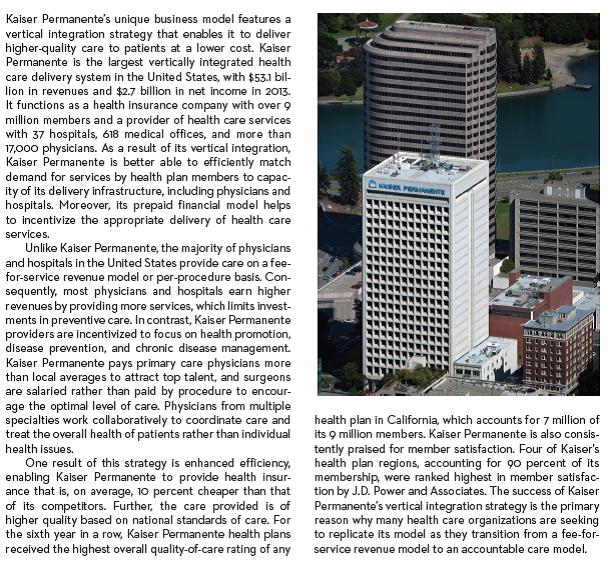Answered step by step
Verified Expert Solution
Question
1 Approved Answer
Kaiser Permanente, a standout among managed health care systems, has become a model of how to deliver good health care cost-effectively. Illustration Capsule 6.4 describes
Kaiser Permanente, a standout among managed health care systems, has become a model of how to deliver good health care cost-effectively. Illustration Capsule 6.4 describes how Kaiser Permanente has made vertical integration a central part of its strategy. What value chain segments has Kaiser Permanente chosen to enter and perform internally? How has vertical integration aided the organization in building competitive advantage? Has vertical integration strengthened its market position? Explain why or why not.

Kaiser Permanente's unique business model features a vertical integration strategy that enables it to deliver higher-quality care to patients at a lower cost. Kaiser Permanente is the largest vertically integrated health care delivery system in the United States, with $53.1 bil- lion in revenues and $2.7 billion in net income in 2013. It functions as a health insurance company with over 9 million members and a provider of health care services with 37 hospitals, 618 medical offices, and more than 17,000 physicians. As a result of its vertical integration, Kaiser Permanente is better able to efficiently match demand for services by health plan members to capac- ity of its delivery infrastructure, including physicians and hospitals. Moreover, its prepaid financial model helps to incentivize the appropriate delivery of health care services. Unlike Kaiser Permanente, the majority of physicians and hospitals in the United States provide care on a fee- for-service revenue model or per-procedure basis. Con- sequently, most physicians and hospitals earn higher revenues by providing more services, which limits invest- ments in preventive care. Incontrast, Kaiser Permanente providers are incentivized to focus on health promotion, disease prevention, and chronic disease management. Kaiser Permanente pays primary care physicians more than local averages to attract top talent, and surgeons are salaried rather than paid by procedure to encour- age the optimal level of care. Physicians from multiple specialties work collaboratively to coordinate care and treat the overall health of patients rather than individual health plan in California, which accounts for 7 million of its 9 milion members. Kaiser Permanente is also consis- tently praised for member satisfaction. Four of Kaiser's health plan regions, accounting for 90 percent of its membership, were ranked highest in member satisfac- tion by J.D. Power and Associates. The success of Kaiser Permanente's vertical integration strategy is the primary reason why many health care organizations are seeking to replicate its model as they transition from a fee-for- service revenue model to an accountable care model. health issues. One result of this strategy is enhanced efficiency, enabling Kaiser Permanente to provide health insur- ance that is, on average, 10 percent cheaper than that of its competitors. Further, the care provided is of higher quality based on national standards of care. For the sixth year in a row, Kaiser Permanente health plans received the highest overall quality-of-care rating of any
Step by Step Solution
★★★★★
3.36 Rating (162 Votes )
There are 3 Steps involved in it
Step: 1
Vertical integration strategy is one where firm expands its business into areas that are at differen...
Get Instant Access to Expert-Tailored Solutions
See step-by-step solutions with expert insights and AI powered tools for academic success
Step: 2

Step: 3

Ace Your Homework with AI
Get the answers you need in no time with our AI-driven, step-by-step assistance
Get Started


